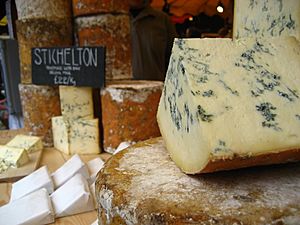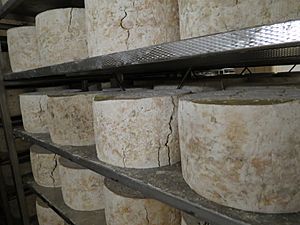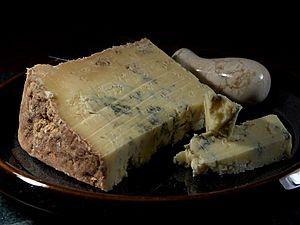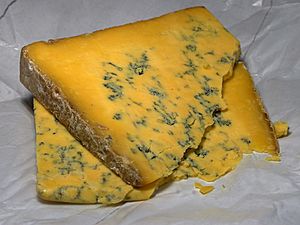List of blue cheeses facts for kids

Blue cheese is a special kind of cheese that has blue or blue-grey spots and lines inside it. These spots are actually a type of mold called Penicillium. This mold gives blue cheese its unique look and strong smell. Cheesemakers add tiny bits of this mold to the cheese on purpose. Blue cheeses are usually kept in cool, damp places, like a cave, to help them age and develop their flavor. You can eat blue cheese by itself, spread it on crackers, crumble it over salads, or melt it into your favorite foods.
Contents
What Makes Blue Cheese Blue?
Blue cheese gets its special color from a type of mold called Penicillium. This mold is completely safe to eat. Cheesemakers add tiny mold spores to the cheese during its creation. Sometimes, they inject the spores into the cheese before it even becomes solid. Other times, they mix the spores right into the cheese after it starts to form.
How Blue Cheese Gets Its Flavor
The mold in blue cheese does more than just add color. It also helps create the strong, unique smell and taste that blue cheese is known for. As the cheese ages, the mold grows and breaks down parts of the cheese. This process gives blue cheese its sharp, tangy, and sometimes creamy flavor. Different types of blue cheese have different tastes, from mild to very strong.
Making Blue Cheese
Making blue cheese is a careful process. After the mold spores are added, the cheese needs to age. This aging usually happens in cool, damp places. These places are often like natural caves, which have the perfect temperature and moisture for the mold to grow well. During aging, the cheesemakers might poke holes in the cheese. These holes allow air to get inside, which helps the mold grow even more and spread throughout the cheese. This is how you get those famous blue streaks and veins.
Popular Types of Blue Cheese
There are many different kinds of blue cheese from all over the world. Each one has its own special taste and texture.
- Roquefort is a famous blue cheese from France. It is made from sheep's milk and has a very strong, salty flavor.
- Gorgonzola comes from Italy. It can be creamy and mild, or firm and strong, depending on how long it has aged.
- Stilton is a well-known blue cheese from England. It is often crumbly and has a rich, deep flavor.
- Danish Blue is a milder blue cheese from Denmark. It is creamy and often used in salads or dressings.
How to Enjoy Blue Cheese
Blue cheese is very versatile, meaning you can use it in many ways.
- You can eat it on its own with crackers or bread.
- It tastes great crumbled over a fresh salad.
- Many people enjoy it melted on a burger or steak.
- It can also be used to make creamy sauces for pasta or vegetables.
- Some people even pair it with fruits like pears or apples, or with a drizzle of honey.
See also




